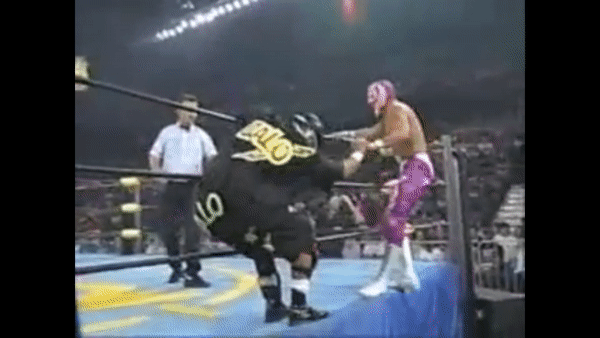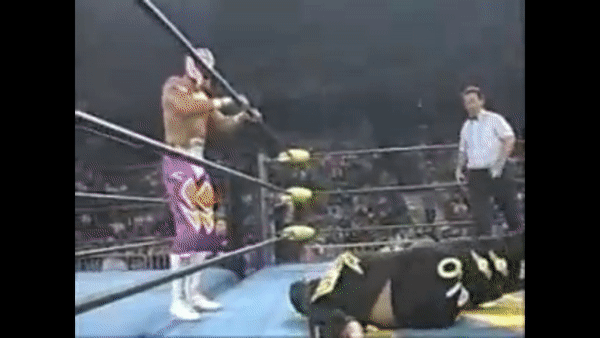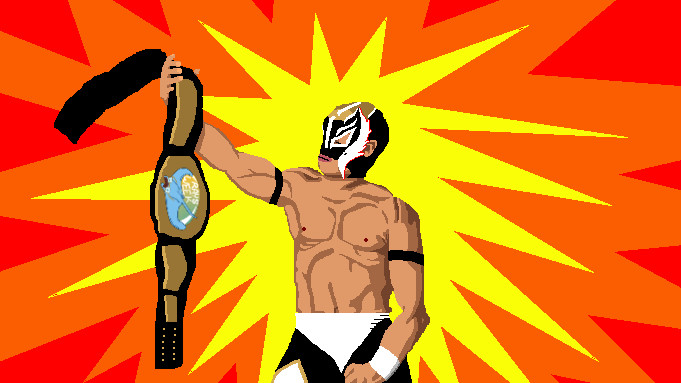Ed. Note: This piece was originally published on April 24, 2020 at Unnamed Temporary Sports Blog. Defector thanks Big Cool Tom Media, LLC for allowing it to be reproduced here during Rays Week.
Wrestling has been a business driven by nostalgia for as long as I’ve known it, which is why I’ve typically been skeptical of older fans claiming the mid-to-late 1990s as a golden era for the form. Sure, Stone Cold and The Rock became cultural icons at a level that the current generation of wrestlers could hardly dream about, but even just a few minutes of the ugly, embarrassing old-timer’s matches that WWE has been putting on abroad over the past few years are enough to make young(er) fans wonder if there ever really was anything worthwhile about stars like Goldberg or DX.
I was one such fan, but I think I was wrong! The past several weeks have given me ample opportunity to dig through the archives and take a self-guided history lesson in sports entertainment, and I’ve found myself legitimately compelled not just by true superstars like Bret Hart and Shawn Michaels but, more than anything, the WCW shows in ’96 and ’97. It turns out that people weren’t lying about how good this stuff was. The NWO in its initial incarnation was definitely cool enough to justify its grip on the merch market 25 years later, Sting was actually kind of badass as their opposition, and the athleticism of the world-class performers in the midcard was marvelous to behold.
The San Diego cruiserweight known as Rey Mysterio—billed as Rey Mysterio Jr. at the time, if you want to be technical about it—jumped out even among that sprawling and star-studded supporting cast, delivering more must-see matches than anybody else on the roster. While it’s absolutely true that Mysterio has been amazing for three decades at this point, viewing his early work for the first time ever has both deepened my appreciation for his career and brought some necessary smiles to my little apartment. In better times, I would almost certainly not have spent as many hours digging through the stacks; in the moment we’ve got, Mysterio’s daredevil brilliance was more than welcome. It was a mood-altering substance.
I first got hooked on young Mysterio thanks to one of his most famous matches—a 1995 bout in ECW against his lucha libre rival Psicosis. As he almost always is, the 5’6″ Mysterio was by far the smaller man in the ring and therefore the clear underdog. But he hurts his opponent and wins the affection of the crowd thanks to an offensive style that’s both determined and graceful. In the span of about two minutes, Mysterio executes four different beautifully acrobatic moves, while also finding time to creatively brutalize Psicosis with multiple chairs. Mysterio has never been known as a hardcore wrestler in the ECW mold, but this performance still sets the standard for everything to come. It is both moronically violent and gorgeously skillful, which means it’s great wrestling.
It wasn’t long before the national spotlight found Mysterio, as the then-dominant WCW brought him in as one of several talented wrestlers in its cruiserweight division. There was no adjustment period for Mysterio on the bigger stage. Less than a month after making his debut, he became the fan-favorite cruiserweight champ.
A great match in his first championship reign is one from September ’96 against the fairly obscure Super Caló. Mysterio selflessly lets his relatively unknown opponent get the lion’s share of the offense in the first ten minutes or so of the match, then asserts his dominance with a set of then-revolutionary attacks. This very bouncy hurricanrana in particular is a delight.

At the end of the match, Mysterio does an absurd double-jump across the ring ropes to get the pinfall. This would obviously be a hilariously impractical way to try and win an actual fight, which might bother some fans. But on the other hand, it’s downright superheroic, and who doesn’t love a real-life superhero?

Mainstream American wrestling fans, especially in that era, didn’t always take to unorthodox performers, especially foreign-coded ones. (“U-S-A!” chants are pretty common in these old shows, and Mysterio was characterized as Mexican despite his California roots.) This makes it doubly impressive that Mysterio received so much adoration from fans so quickly. It’s the mask, at least from my point of view, that makes the character so universally popular. Based on size alone, Óscar Gutiérrez is the last guy you’d ever believe could win a big fight. But when he puts on that mask and becomes Rey Mysterio, the equation changes such that his size becomes a storytelling advantage. In the mask, Mysterio is an everyman who can accomplish the unbelievable and defeat the impossible.
The mask is the centerpiece of my favorite spot from another Mysterio classic—Halloween Havoc 1996 against the masterful Dean Malenko. As is the norm for these two, this match is practically flawless, filled with both savvy technical skill and high-stakes emotional intensity. Malenko stole Mysterio’s mask in the build-up to their battle, but the little guy was able both to get it back and execute an impressive mid-ring costume change with the help of some quick, flashy innovation.
As every wrestling promotion seems to eventually do with an organically popular character, WCW ruined Mysterio, specifically by stripping away his mask as part of a stipulation in what was basically a throwaway match in 1999. Despite losing his most important trademark, Mysterio continued working for WCW until the bitter end, even appearing unmasked in the final episode of “Nitro.”
Mysterio spent the next chapter of his career in the indies, but while his legacy might merely have been that of a cult favorite from a defunct company, the highest heights of his career were yet to come. He signed with WWE in 2002, and if he’s not that company’s greatest performer of the past two decades in terms of championship reigns or red-hot peaks, he is certainly among the best in terms of consistent excellence and enduring popularity.
Even after leaving WWE for a few years and returning in 2018, Mysterio has maintained an in-ring ability that defies conventional wisdom. Just this week on “Raw,” Mysterio had a very good match with Murphy that could have been great in front of a crowd. And at 2019's Survivor Series, he took advantage of a title shot against Brock Lesnar and teamed up with his son to almost bring down the Beast in deliriously entertaining fashion. Bear in mind while watching these that Mysterio is now in his mid-40s.
As a general rule it’s both healthy and usually correct to tune out people who are too sentimental about the wrestling of their youth, or at least to take their assessments with a grain of salt. That said, I am absolutely going to be nostalgic for that Mysterio And Son match 20 years from now.






